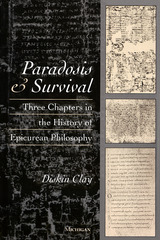3 books about Clay, Diskin

Archilochos Heros
The Cult of Poets in the Greek Polis
Diskin Clay
Harvard University Press, 2004
The discovery of the Mnesiepes inscription on Paros revealed the third century B.C. belief that the young Archilochos was transformed into a poet by an encounter with the Muses. It also revealed that the poet had become the object of a cult by his fellow islanders as he was transformed in death to a local hero. This is the first attempt to trace the history of this cult from the late sixth century B.C. to the third century A.D.. The author also integrates the iconography of the poet into the history of this cult, and addresses for the first time the larger phenomenon of the cult of poets in the Greek states. This study provides appendices giving sources of information for these cults, including the text of the Mnesiepes inscription. It is illustrated by in-text figures and plates.
[more]

Paradosis and Survival
Three Chapters in the History of Epicurean Philosophy
Diskin Clay
University of Michigan Press, 1998
Paradosis and Survival presents Diskin Clay's fifteen essays devoted to recovering the three main phases of Epicureanism in antiquity: the origin in the first generation of the school in Athens; its spread to Italy in the first century b.c.e.; and its movement to Lycia in the second century c.e. Clay recognizes the subtle intertwining of philosophy and lifestyle, and he makes use of papyri and inscriptions as well as familiar philosophical texts to illuminate both.
The first series of essays concentrates on the mechanisms Epicurus devised to assure the survival of the philosophy beyond its Athenian roots. Clay presents social history on an equal footing with doctrine, and offers for the first time evidence for hero cults among philosophers who believed that the soul died with the body. The second set of essays concentrates Epicureanism in the age of Cicero, Philodemus, and Lucretius. In the four essays on De Rerum Natura, Lucretius is viewed not as a transparency through which we can view the Greek of Epicurus, but a Roman philosopher in control of both doctrine and rhetoric. The book concludes with the study of the philosophy in Oenoanda, Lycia, in which the author brilliantly situates post-1968 discoveries from Oenoanda and the Villa de Papiri in Herculaneum in the context of the second-century mountain city.
This study of Epicureanism as a social movement will be of interest to students of ancient philosophy and the philosophy of early modern Europe, when Epicureanism was revived. In addition, scholars of the New Testament will find parallels to the rise and spread of Christianity.
Diskin Clay is the R. J. R. Nabisco Distinguished Professor of Classical Studies, Duke University.
The first series of essays concentrates on the mechanisms Epicurus devised to assure the survival of the philosophy beyond its Athenian roots. Clay presents social history on an equal footing with doctrine, and offers for the first time evidence for hero cults among philosophers who believed that the soul died with the body. The second set of essays concentrates Epicureanism in the age of Cicero, Philodemus, and Lucretius. In the four essays on De Rerum Natura, Lucretius is viewed not as a transparency through which we can view the Greek of Epicurus, but a Roman philosopher in control of both doctrine and rhetoric. The book concludes with the study of the philosophy in Oenoanda, Lycia, in which the author brilliantly situates post-1968 discoveries from Oenoanda and the Villa de Papiri in Herculaneum in the context of the second-century mountain city.
This study of Epicureanism as a social movement will be of interest to students of ancient philosophy and the philosophy of early modern Europe, when Epicureanism was revived. In addition, scholars of the New Testament will find parallels to the rise and spread of Christianity.
Diskin Clay is the R. J. R. Nabisco Distinguished Professor of Classical Studies, Duke University.
[more]

Plato’s Symposium
Issues in Interpretation and Reception
James H. Lesher
Harvard University Press, 2006
In his Symposium, Plato crafted a set of speeches in praise of love that has influenced writers and artists from antiquity to the present. Early Christian writers read the dialogue's 'ascent passage' as a vision of the soul's journey to heaven. Ficino's commentary on the Symposium inspired poets and artists throughout Renaissance Europe and introduced 'a Platonic love' into common speech. Themes or images from the dialogue have appeared in paintings or sketches by Rubens, David, Feuerbach, and La Farge, as well as in musical compositions by Satie and Bernstein. The dialogue's view of love as 'desire for eternal possession of the good' is still of enormous philosophical interest in its own right. Nevertheless, questions remain concerning the meaning of specific features, the significance of the dialogue as a whole, and the character of its influence. This volume brings together an international team of scholars to address such questions.
[more]
READERS
Browse our collection.
PUBLISHERS
See BiblioVault's publisher services.
STUDENT SERVICES
Files for college accessibility offices.
UChicago Accessibility Resources
home | accessibility | search | about | contact us
BiblioVault ® 2001 - 2024
The University of Chicago Press









